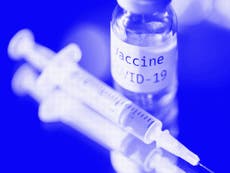Covid infection rates drop across England, except in northeast
An estimated 521,300 people England had Covid-19 between 22 and 28 November, says Office for National Statistics
Your support helps us to tell the story
From reproductive rights to climate change to Big Tech, The Independent is on the ground when the story is developing. Whether it's investigating the financials of Elon Musk's pro-Trump PAC or producing our latest documentary, 'The A Word', which shines a light on the American women fighting for reproductive rights, we know how important it is to parse out the facts from the messaging.
At such a critical moment in US history, we need reporters on the ground. Your donation allows us to keep sending journalists to speak to both sides of the story.
The Independent is trusted by Americans across the entire political spectrum. And unlike many other quality news outlets, we choose not to lock Americans out of our reporting and analysis with paywalls. We believe quality journalism should be available to everyone, paid for by those who can afford it.
Your support makes all the difference.Coronavirus infection rates in England have dropped across all regions except the northeast, while the UK’s R value has further fallen, according to new data.
In the week up to 28 November, the percentage of people testing positive for the disease is estimated to have decreased throughout much of the country, the Office for National Statistics (ONS) said in its latest Covid survey.
In the northeast, rates appear to have levelled off, the ONS added.
Yorkshire and the Humber has the highest rate with an estimated 1.7 per cent of people in private households testing positive, followed by the northeast (1.6 per cent) and northwest (1.6 per cent).
Eastern England has the lowest rate at 0.4 per cent.
This comes as the government’s Scientific Advisory Group for Emergencies (Sage) announced that the UK’s R value has dipped to between 0.8 and 1.0.
This means 10 people with Covid-19 will on average infect between eight and 10 other individuals.
Last week, the R rate was estimated to be between 0.9 and 1.
Sage said the UK’s the growth rate currently ranged between -3 per cent and -1 per cent, indicating the pandemic is shrinking quicker than in previous weeks.
An estimated 521,300 people in England had Covid-19 between 22 and 28 November, the ONS said. This is the equivalent of around 0.96 per cent of the population.
The figures represent a drop from 633,000 people, or 1.16 per cent of the population, who were estimated to have been infected in the previous week.
There was an average of 25,700 new daily cases in the week up to 28 November, the ONS added. This is the lowest estimate since the end of September, and points to the success of the national lockdown in cutting the spread of the virus.
A decrease in positivity rates among all age groups was also noted over the same period, according to the ONS. Rates remain highest among secondary school-aged children.
Positivity rates in Northern Ireland seem to have peaked around the middle of October, and are continuing to decrease, the ONS said. Scotland is showing early signs of a decline in infections too.
In Wales, the percentage of those testing positive is no longer falling. An estimated one in 170 people in the country had the disease in the week up to 28 November.
Addressing the new ONS survey, Professor James Naismith, director of the Rosalind Franklin Institute, said: “It is clear that on a national level, the lockdown has had the predicted effect.
“We are currently on the downward slope of the second wave. There can be no celebration, too many have died; but we have managed the second wave somewhat better than the first. The lower we get the daily number of infections, the less risk the Christmas relaxation poses.”
However, he warned that “it is important for us to think about what will happen to the numbers” over the holiday period.
The ONS estimates are based on a survey of thousands of people in households whether they have symptoms or not. The figures do not include people staying in hospitals, care homes or other institutional settings.

Join our commenting forum
Join thought-provoking conversations, follow other Independent readers and see their replies
Comments